Fuji Film ASK300 Thermal Photo Printer User Manual
Fuji Film Corporation Thermal Photo Printer
User Manual
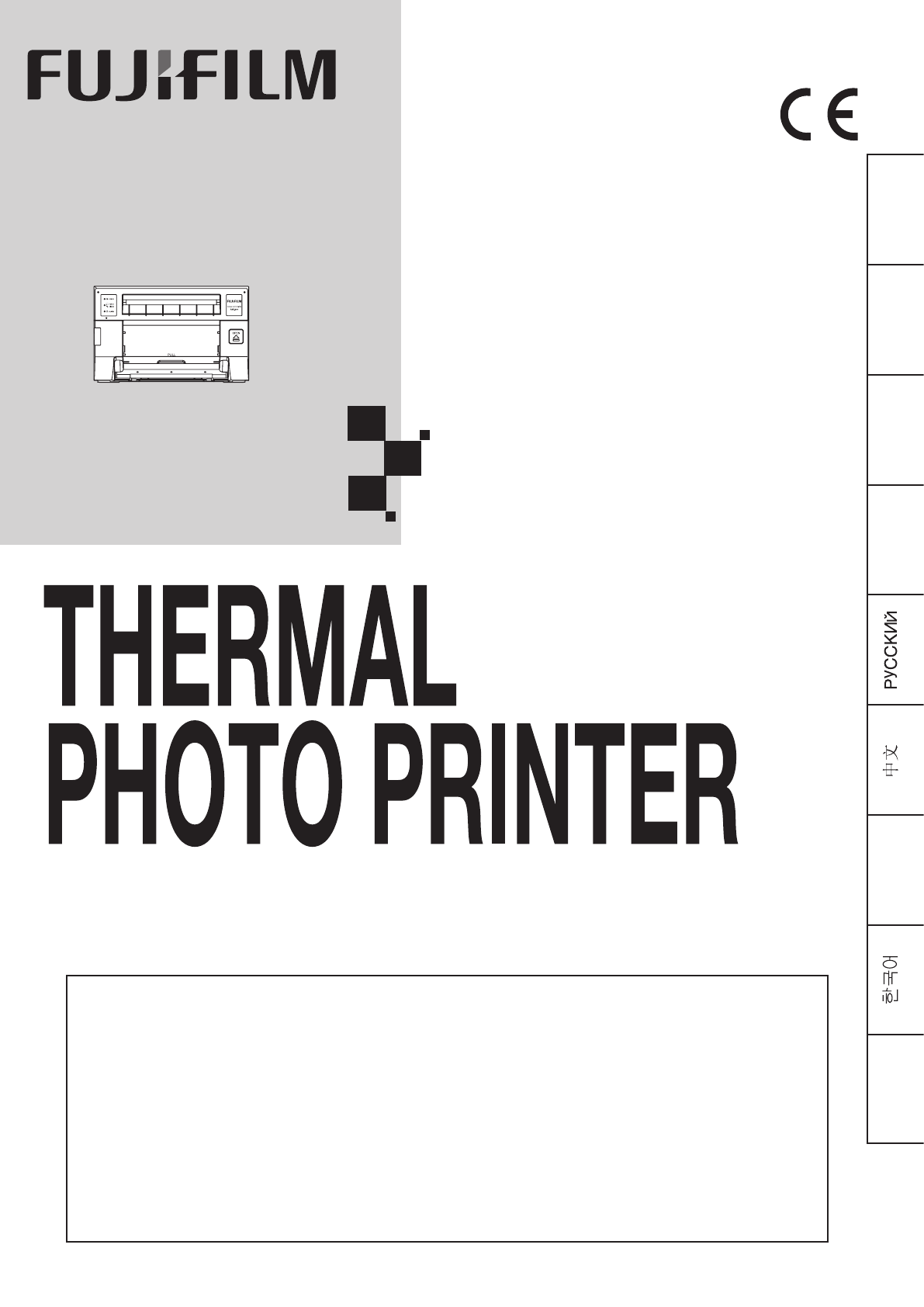
FRANÇAIS ENGLISHDEUTSCHESPAÑOL
THERMAL PHOTO PRINTER
MODEL
ASK-300
OPERATION MANUAL
THIS OPERATION MANUAL IS IMPORTANT
TO YOU.
PLEASE READ IT BEFORE USING YOUR
THERMAL PHOTO PRINTER.
Hereby, FUJIFILM Corporation, declares that this thermal photo printer is in compliance
with the essential requirements and other relevant provisions of Directive 1999/5/EC.
Hiermit erklärt FUJIFILM Corporation, dass dieser digitale Farbdrucker in
Übereinstimmung mit den grundlegenden Anforderungen und den übrigen einschlägigen
Bestimmungen der Richtlinie 1999/5/EG entspricht.
Par la présente, FUJIFILM Corporation, déclare l’imprimante couleur numérique est
conforme aux exigences essentielles et aux autres dispositions pertinentes de la directive
1999/5/CE.
Por medio de la presente FUJIFILM Corporation declara que esta impresora digital en
color cumple con los requisitos esenciales y cualesquiera otras disposiciones aplicables o
exigibles de la Directiva 1999/5/CE.
この印刷物は再生紙を使用しています。
日本語
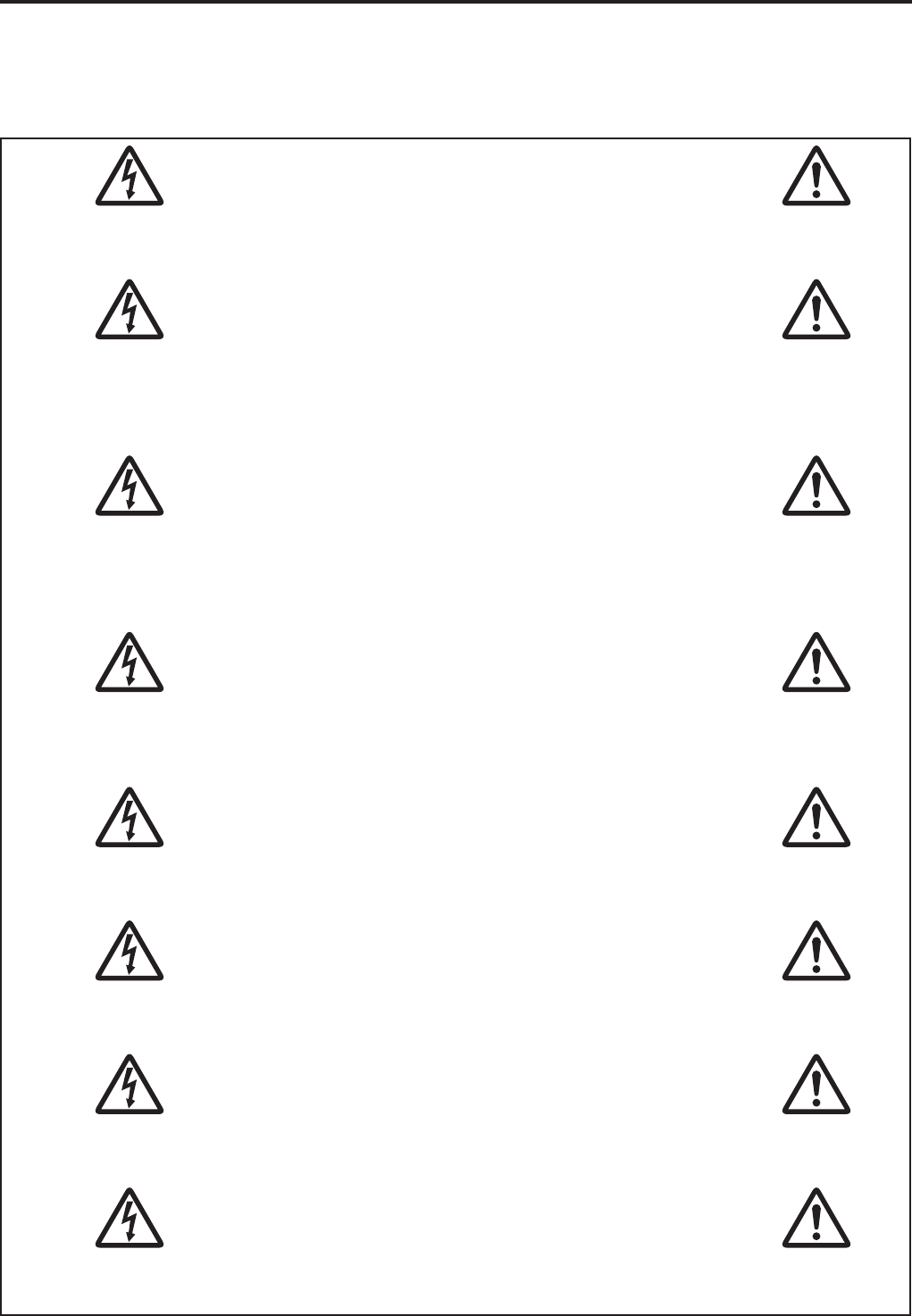
2
WARNING :
TO PREVENT FIRE OR SHOCK HAZARD, DO NOT EXPOSE THIS APPLIANCE TO RAIN OR
MOISTURE.
CAUTION:
RISK OF ELECTRIC SHOCK DO NOT OPEN.
TO REDUCE THE RISK OF ELECTRIC SHOCK, DO NOT REMOVE COVER (OR BACK).
NO USER-SERVICEABLE PARTS INSIDE. REFER SERVICING TO QUALIFIED SERVICE PERSONNEL.
ACHTUNG:
GEFAHR EINES STROMSCHLAGES; BITTE NICHT ÖFFNEN.
UM DIE GEFAHR EINES STROMSCHLAGES ZU VERMEIDEN, ÖFFNEN SIE AUF KEINEN FALL DIE
ABDECKUNG (ODER DIE RÜCKSEITE) DES GERÄTES.
IM INNEREN DES GERÄTES BEFINDEN SICH KEINERLEI TEILE, DIE DURCH DEN BENUTZER ZU
WARTEN WÄREN. ÜBERLASSEN SIE DIE WARTUNG BITTE QUALIFIZIERTEM SERVICEPERSONAL.
ATTENTION:
RISQUE DE CHOC ELECTRIQUE NE PAS OUVRIR.
AFIN DE REDUIRE LE RISQUE DE CHOC ELECTRIQUE NE PAS DEMONTER LE COUVERCLE (OU
L’ARRIERE).
LES PIECES A L’INTERIEUR NE SONT PAS REPARABLES PAR L’UTILISATEUR.
VEUILLEZ VOUS REFERER AU PERSONNEL DE SERVICE QUALIFIE.
PRECAUCIÓN:
RIESGO DE DESCARGA ELECTRICA, NO ABRIR.
PARA REDUCIR EL RIESGO DE DESCARGA, NO QUITE LA CUEBIERTA (O LA PARTE TRASERA)
EN EL INTERIOR NO HAY PARTES QUE PUEDAN SER REPARADAS POR EL USUARIO. REFIERA LA
REPARACIÓN A PERSONAL DE SERVICIO CALIFICADO.
CAUTION:
RISK OF ELECTRIC SHOCK DO NOT OPEN.
TO REDUCE THE RISK OF ELECTRIC SHOCK, DO NOT REMOVE COVER (OR BACK).
NO USER-SERVICEABLE PARTS INSIDE. REFER SERVICING TO QUALIFIED SERVICE PERSONNEL.
CAUTION:
RISK OF ELECTRIC SHOCK DO NOT OPEN.
TO REDUCE THE RISK OF ELECTRIC SHOCK, DO NOT REMOVE COVER (OR BACK).
NO USER-SERVICEABLE PARTS INSIDE. REFER SERVICING TO QUALIFIED SERVICE PERSONNEL.
CAUTION:
RISK OF ELECTRIC SHOCK DO NOT OPEN.
TO REDUCE THE RISK OF ELECTRIC SHOCK, DO NOT REMOVE COVER (OR BACK).
NO USER-SERVICEABLE PARTS INSIDE. REFER SERVICING TO QUALIFIED SERVICE PERSONNEL.
CAUTION:
RISK OF ELECTRIC SHOCK DO NOT OPEN.
TO REDUCE THE RISK OF ELECTRIC SHOCK, DO NOT REMOVE COVER (OR BACK).
NO USER-SERVICEABLE PARTS INSIDE. REFER SERVICING TO QUALIFIED SERVICE PERSONNEL.
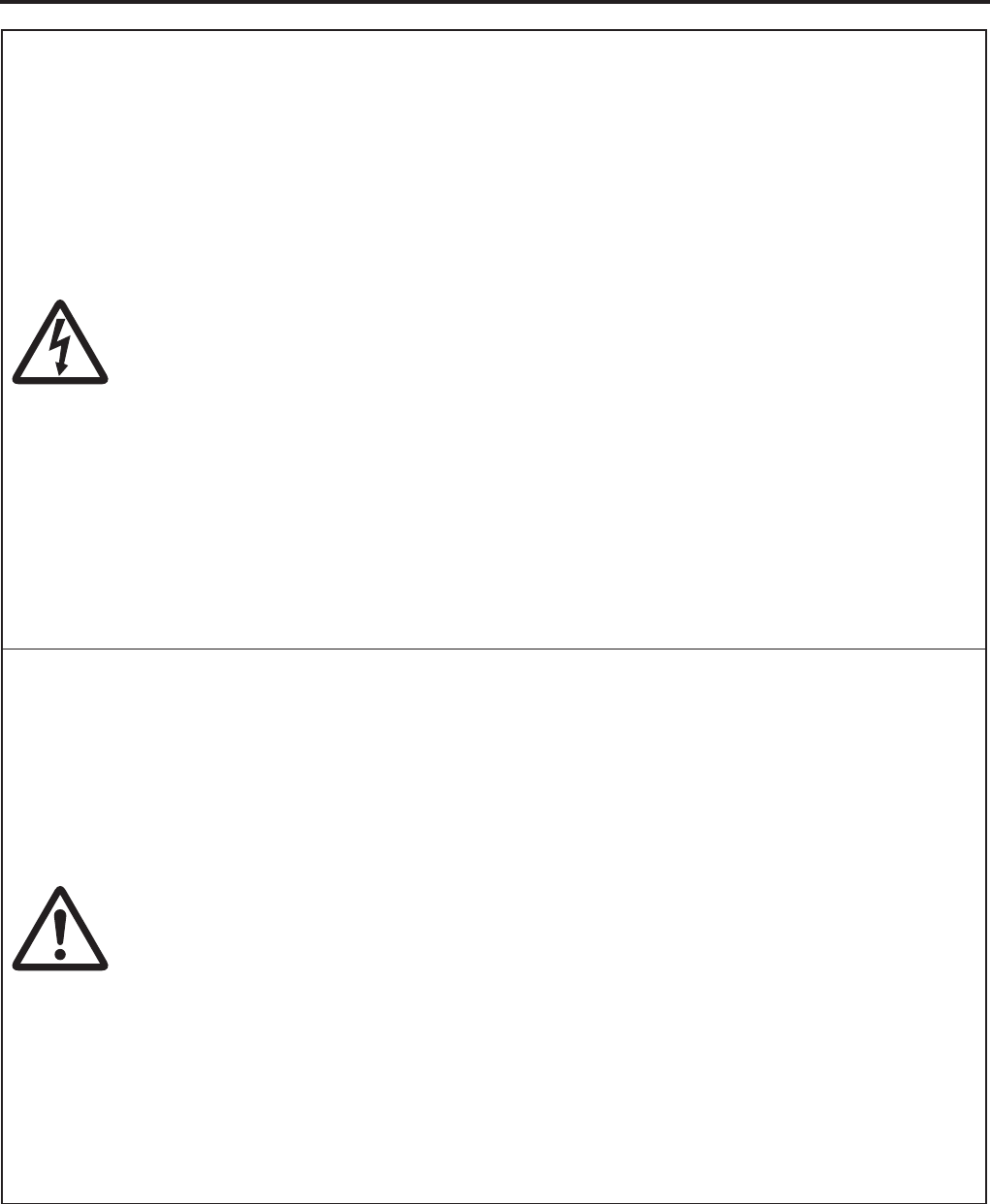
3
The lightning ash with arrowhead symbol, within an equilateral triangle, is intended to alert the user to the
presence of uninsulated “dangerous voltage” within the product’s enclosure that may be of sufcient magnitude
to constitute the risk of electric shock.
Das Blitzsymbol innerhalb eines gleichschenkligen Dreiecks ist dazu bestimmt, den Benutzer zu alarmieren und
darauf hinzuweisen, dass nicht isolierte “gefährliche Spannungen” innerhalb des Produktgehäuses auftreten,
die zu einem lebensgefährlichen Stromschlag führen können.
Le symbole composé d’un éclair terminé par une èche, avec un triangle équilatéral, est destiné à avertir
l’utilisateur de la présence d’un “voltage dangereux” sans isolation à l’intérieur du produit d’une force sufsant à
provoquer un risque de choc électrique.
Le symbole “Courant alternatif” indique que l’appareil ne peut fonctionner qu’avec du courant alternatif.
El destello relampagueante con el símbolo de cabeza de echa, dentro de un triángulo equilátero, pretende
alertar al usuario de la presencia de “voltaje peligroso” no aislado dentro del producto adjunto, que puede ser
de una magnitud suciente para constituir un riesgo de descarga eléctrica.
RUSSIAN
XXXXXXXXXXXXXXXXXXXXXXXXXXXXXXXXXXXXXXXXXXXXXXXXXXXXXXXXXXXXXXXXXXXXXXXXXX
XXXXXXXXXXXXXXXXXXXXXXXXXXXXXXXXXXXXXXXXXXXXXXXXXXXXXXXXXXXXXXXXXXXXXXXXXX
XXXXXXXXXXXXXXXXXXXXXXXXXXXXXXXXXXXXXXXXXXXXXXX
CHINESE
XXXXXXXXXXXXXXXXXXXXXXXXXXXXXXXXXXXXXXXXXXXXXXXXXXXXXXXXXXXXXXXXXXXXXXXXXX
XXXXXXXXXXXXXXXXXXXXXXXXXXXXXXXXXXXXXXXXXXXXXXXXXXXXXXXXXXXXXXXXXXXXXXXXXX
XXXXXXXXXXXXXXXXXXXXXXXXXXXXXXXXXXXXXXXXXXXXXXx
TIWANESE
XXXXXXXXXXXXXXXXXXXXXXXXXXXXXXXXXXXXXXXXXXXXXXXXXXXXXXXXXXXXXXXXXXXXXXXXXX
XXXXXXXXXXXXXXXXXXXXXXXXXXXXXXXXXXXXXXXXXXXXXXXXXXXXXXXXXXXXXXXXXXXXXXXXXX
XXXXXXXXXXXXXXXXXXXXXXXXXXXXXXXXXXXXXXXXXXXXXXX
KOREAN
XXXXXXXXXXXXXXXXXXXXXXXXXXXXXXXXXXXXXXXXXXXXXXXXXXXXXXXXXXXXXXXXXXXXXXXXXX
XXXXXXXXXXXXXXXXXXXXXXXXXXXXXXXXXXXXXXXXXXXXXXXXXXXXXXXXXXXXXXXXXXXXXXXXXX
XXXXXXXXXXXXXXXXXXXx
The exclamation point within an equilateral triangle is intended to alert the user to the presence of important
operating and maintenance (servicing) instructions in the literature accompanying the appliance.
Das Ausrufezeichen innerhalb eines gleichschenkligen Dreiecks ist dazu bestimmt, den Benutzer zu alarmieren
und darauf hinzuweisen, dass sich in der im Lieferumfang dieses Gerätes enthaltenen Literatur, wichtige
Betriebs- und Wartungs- (Service) Informationen benden.
Le symbole composé d’un point d’exclamation avec un triangle équilatéral est destiné à avertir l’utilisateur de
la présence d’instructions de fonctionnement et d’entretien (de service) importantes dans la documentation
accompagnant le dispositif.
El punto de exclamación dentro de un triángulo equilátero pretende alertar al usuario de la presencia de
instrucciones de operación y mantenimiento (servicio) importantes en la literatura que acompaña al aparato.
RUSSIAN
XXXXXXXXXXXXXXXXXXXXXXXXXXXXXXXXXXXXXXXXXXXXXXXXXXXXXXXXXXXXXXXXXXXXXXXXXX
XXXXXXXXXXXXXXXXXXXXXXXXXXXXXXXXXXXXXXXXXXXXXXXXXXXXXXXXXXXXXXXXXXXXXXXXXX
XXXXXXXXXXXXXXXXXXXXXXXXXXXXXXXXXXXXXXXXXXXXXXX
CHINESE
XXXXXXXXXXXXXXXXXXXXXXXXXXXXXXXXXXXXXXXXXXXXXXXXXXXXXXXXXXXXXXXXXXXXXXXXXX
XXXXXXXXXXXXXXXXXXXXXXXXXXXXXXXXXXXXXXXXXXXXXXXXXXXXXXXXXXXXXXXXXXXXXXXXXX
XXXXXXXXXXXXXXXXXXXXXXXXXXXXXXXXXXXXXXXXXXXXXXx
TIWANESE
XXXXXXXXXXXXXXXXXXXXXXXXXXXXXXXXXXXXXXXXXXXXXXXXXXXXXXXXXXXXXXXXXXXXXXXXXX
XXXXXXXXXXXXXXXXXXXXXXXXXXXXXXXXXXXXXXXXXXXXXXXXXXXXXXXXXXXXXXXXXXXXXXXXXX
XXXXXXXXXXXXXXXXXXXXXXXXXXXXXXXXXXXXXXXXXXXXXXX
KOREAN
XXXXXXXXXXXXXXXXXXXXXXXXXXXXXXXXXXXXXXXXXXXXXXXXXXXXXXXXXXXXXXXXXXXXXXXXXX
XXXXXXXXXXXXXXXXXXXXXXXXXXXXXXXXXXXXXXXXXXXXXXXXXXXXXXXXXXXXXXXXXXXXXXXXXX
XXXXXXXXXXXXXXXXXXXx
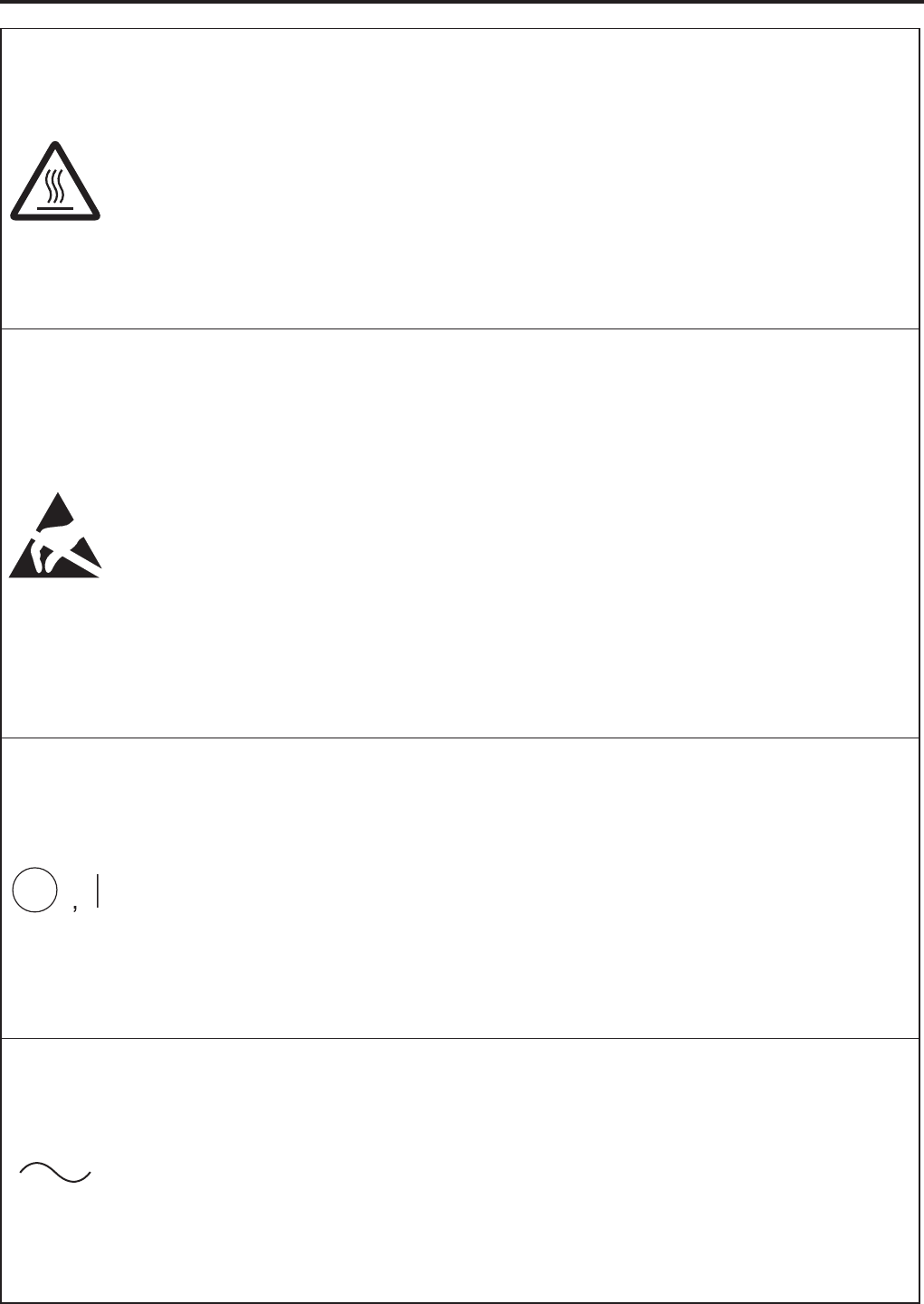
4
The “Caution, hot surface” symbol indicates that the marked item may be hot and should not be touched.
Das Symbol “Achtung, heiße Oberäche” zeigt an, dass der markierte Bereich unter Umständen heiß ist und
nicht berührt werden sollte.
Le symbole “Attention, surface chaude” indique que l’élément ainsi marqué peut être très chaud et ne doit pas
être touché.
El símbolo “Precaución, supercie caliente” indica que el ítem marcado puede estar caliente y no se debe tocar.
RUSSIAN
XXXXXXXXXXXXXXXXXXXXXXXXXXXXXXXXXXXXXXXXXXXXXXXXXXXXXXXXXXXXXXXXX
CHINESE
XXXXXXXXXXXXXXXXXXXXXXXXXXXXXXXXXXXXXXXXXXXXXXXXXXXXXXXXXXXXXXXXX
TIWANESE
XXXXXXXXXXXXXXXXXXXXXXXXXXXXXXXXXXXXXXXXXXXXXXXXXXXXXXXXXXXXXXXXX
KOREAN
XXXXXXXXXXXXXXXXXXXXXXXXXXXXXXXXXXXXXXXXXXXXXXXXXXXXXXXXXXXXXXXXX
The “Electro Static Discharge (ESD) warning” symbol indicates that trouble (including equipment malfunction)
due to static electricity may occur in certain conditions.
Das Symbol für “elektrostatische Entladung” (ESE) zeigt an, dass es aufgrund statischer Elektrizität unter
bestimmten Bedingungen zu Störungen (einschließlich Fehlbetrieb der Ausrüstung) kommen kann.
Le symbole “Avertissement de décharge électrostatique (DES)” indique que des problèmes (incluant le
dysfonctionnement de l’appareil) peuvent survenir dans certaines conditions à cause de l’électricité statique.
El símbolo de “Advertencia de descarga electroestática (ESD)” indica que puede producirse un problema
(incluyendo mal funcionamiento del equipo) debido a electricidad estática en determinadas condiciones.
RUSSIAN
XXXXXXXXXXXXXXXXXXXXXXXXXXXXXXXXXXXXXXXXXXXXXXXXXXXXXXXXXXXXXXXXXXXXXXXXXX
XXXXXXXXXXXXXXXXXXXXXXXXXXXXXXXXXXXXXXXXXXXXXXXXXXXXXXXX
CHINESE
XXXXXXXXXXXXXXXXXXXXXXXXXXXXXXXXXXXXXXXXXXXXXXXXXXXXXXXXXXXXXXXXXXXXXXXXXX
XXXXXXXXXXXXXXXXXXXXXXXXXXXXXXXXXXXXXXXXXXXXXXXXXXXXXXXx
TIWANESE
XXXXXXXXXXXXXXXXXXXXXXXXXXXXXXXXXXXXXXXXXXXXXXXXXXXXXXXXXXXXXXXXXXXXXXXXXX
XXXXXXXXXXXXXXXXXXXXXXXXXXXXXXXXXXXXXXXXXXXXXXXXXXXXXXXX
KOREAN
XXXXXXXXXXXXXXXXXXXXXXXXXXXXXXXXXXXXXXXXXXXXXXXXXXXXXXXXXXXXXXXXXXXXXXXXXX
XXXXXXXXXXXXXXXXXXXXXXXXXXXXx
The “OFF/ON symbol indicates connection to or disconnection from the mains, at least for mains switches.
Das “AUS/EIN”-Symbol zeigt den Netzschalter der zum trennen der Netzspannung dient, an.
Le symbole “ARRET/MARCHE” indique la connexion ou la déconnexion avec le courant du secteur, au moins
pour les interrupteurs secteur.
El símbolo “DESACTIVADO/ACTIVADO” indica la conexión o desconexión de la corriente, como mínimo para
los interruptores de corriente.
RUSSIAN
XXXXXXXXXXXXXXXXXXXXXXXXXXXXXXXXXXXXXXXXXXXXXXXXXXXXXXXXXXXXXXXXX
CHINESE
XXXXXXXXXXXXXXXXXXXXXXXXXXXXXXXXXXXXXXXXXXXXXXXXXXXXXXXXXXXXXXXXX
TIWANESE
XXXXXXXXXXXXXXXXXXXXXXXXXXXXXXXXXXXXXXXXXXXXXXXXXXXXXXXXXXXXXXXXX
KOREAN
XXXXXXXXXXXXXXXXXXXXXXXXXXXXXXXXXXXXXXXXXXXXXXXXXXXXXXXXXXXXXXXXX
The “Alternating current” symbol indicates that the equipment is suitable for alternating current only.
Das “Wechselstrom”-Symbol zeigt an, dass sich das Gerät ausschließlich für Wechselstrom eignet.
Le symbole “Courant alternatif” indique que l’appareil ne peut fonctionner qu’avec du courant alternatif.
El símbolo de “Corriente alterna” indica que el equipo es adecuado solo para corriente alterna.
RUSSIAN
XXXXXXXXXXXXXXXXXXXXXXXXXXXXXXXXXXXXXXXXXXXXXXXXXXX
CHINESE
XXXXXXXXXXXXXXXXXXXXXXXXXXXXXXXXXXXXXXXXXXXXXXXXXXXXXXXXXXXXXXXXXXXXXXXX
TIWANESE
XXXXXXXXXXXXXXXXXXXXXXXXXXXXXXXXXXXXXXXXXXXXXXXXXXXXXXXXXXXXXXXXXXXXXXXX
KOREAN
XXXXXXXXXXXXXXXXXXXXXXXXXXXXXXXXXXXXXXXXXXXXXXXXXXXXXXXXXXXXXXXXXXXXXXXX
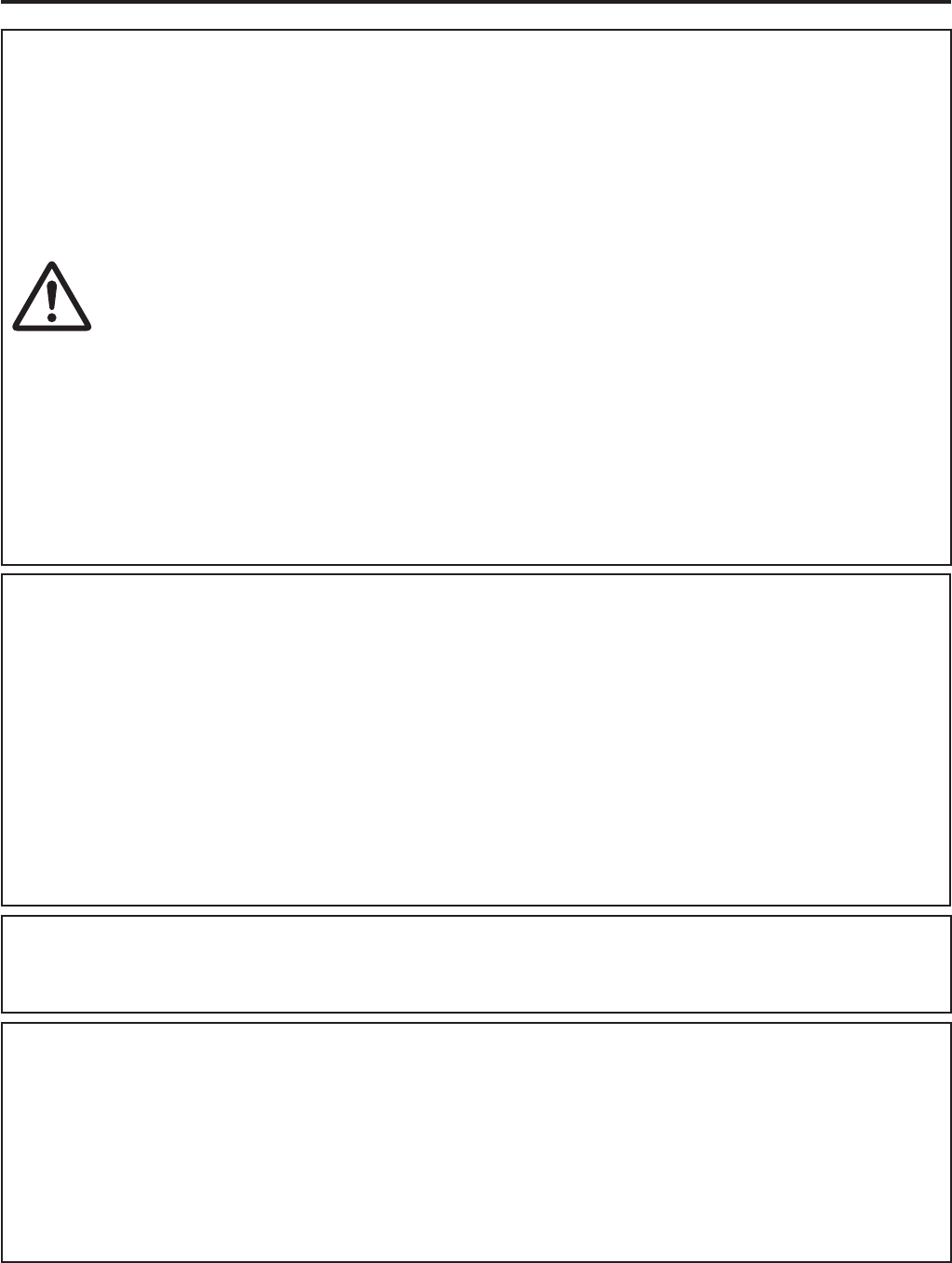
5
WARNING:
The socket outlet shall be installed near the equipment and shall be easily accessible.
WARNUNG:
Die Steckdose sollte in der Nähe des Geräts installiert und leicht zugänglich sein.
ATTENTION:
La prise de courant doit être installée à proximité de l’appareil et doit être facilement
accessible.
ADVERTENCIA:
La toma de corriente debe estar instalada cerca del equipo y de tal forma que pueda
llegar fácilmente a la misma.
WARNING:
The socket outlet shall be installed near the equipment and shall be easily accessible.
WARNING:
The socket outlet shall be installed near the equipment and shall be easily accessible.
WARNING:
The socket outlet shall be installed near the equipment and shall be easily accessible.
WARNING:
The socket outlet shall be installed near the equipment and shall be easily accessible.
For the customers in the U.S.A.
CAUTION:
Changes or modications not expressly approved by the party responsible for compliance could void
the user’s authority to operate the equipment.
NOTE:
This equipment has been tested and found to comply with the limits for a Class A digital device,
pursuant to Part 15 of the FCC Rules. These limits are designed to provide reasonable protection
against harmful interference when the equipment is operated in a commercial environment. This
equipment generates, uses, and can radiate radio frequency energy and, if not installed and used in
accordance with the instruction manual, may cause harmful interference to radio communications.
Operation of this equipment in a residential area is likely to cause harmful interference in which case
the user will be required to correct the interference at his or her own expense.
For the customers in Canada
This Class A digital apparatus complies with Canadian ICES-003.
Cet appareil numérique de la classe A est conforme à la norme NMB-003 du Canada.
For the customers in the U.S.A. and Canada
Operation is subject to the following two conditions;
(1) this device may not cause interference, and
(2) this device must accept any interference, including interference that may cause undesired
operation of the device.
Le fonctionnement est soumis aux deux conditions suivantes :
(1) cet appareil peut ne pas causer d’interférence, et
(2) cet appareil doit accepter toute interférence, y compris les interférences pouvant causer un
fonctionnement non désiré de l’appareil.
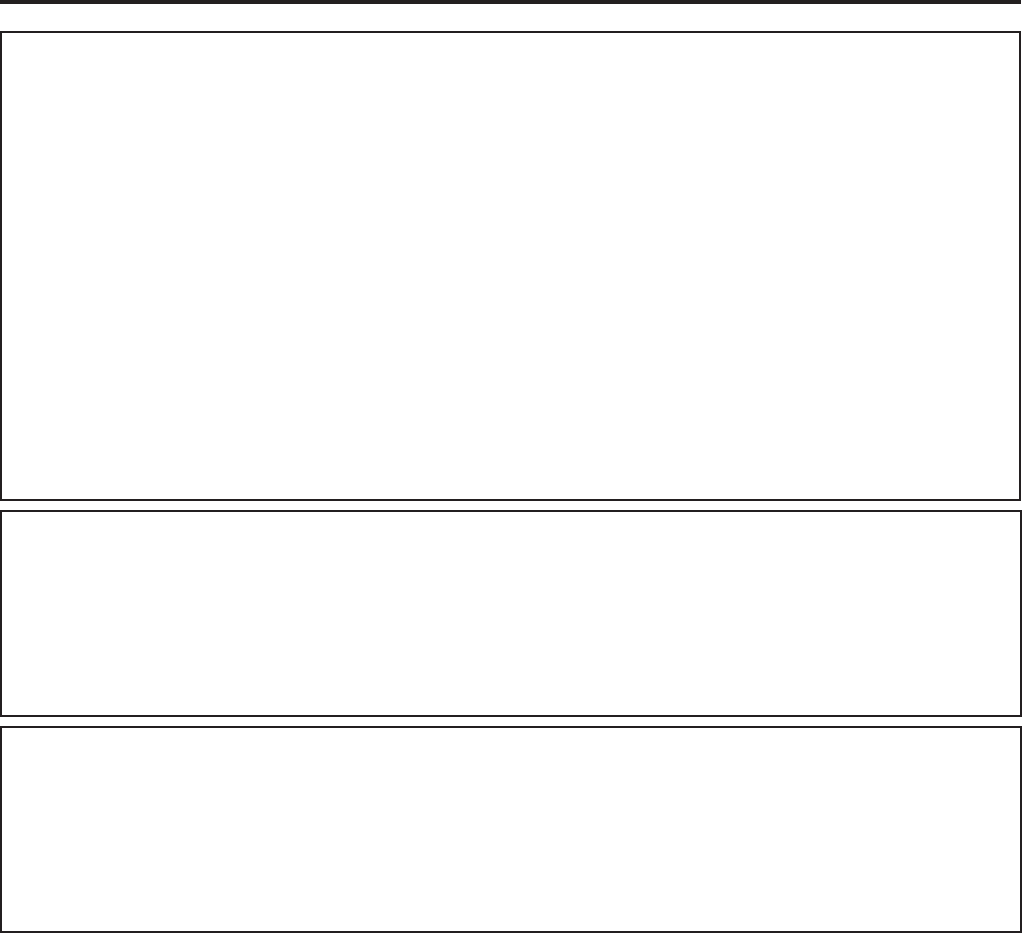
6
For the customers in China
For the customers in Taiwan
For the customers in Korea
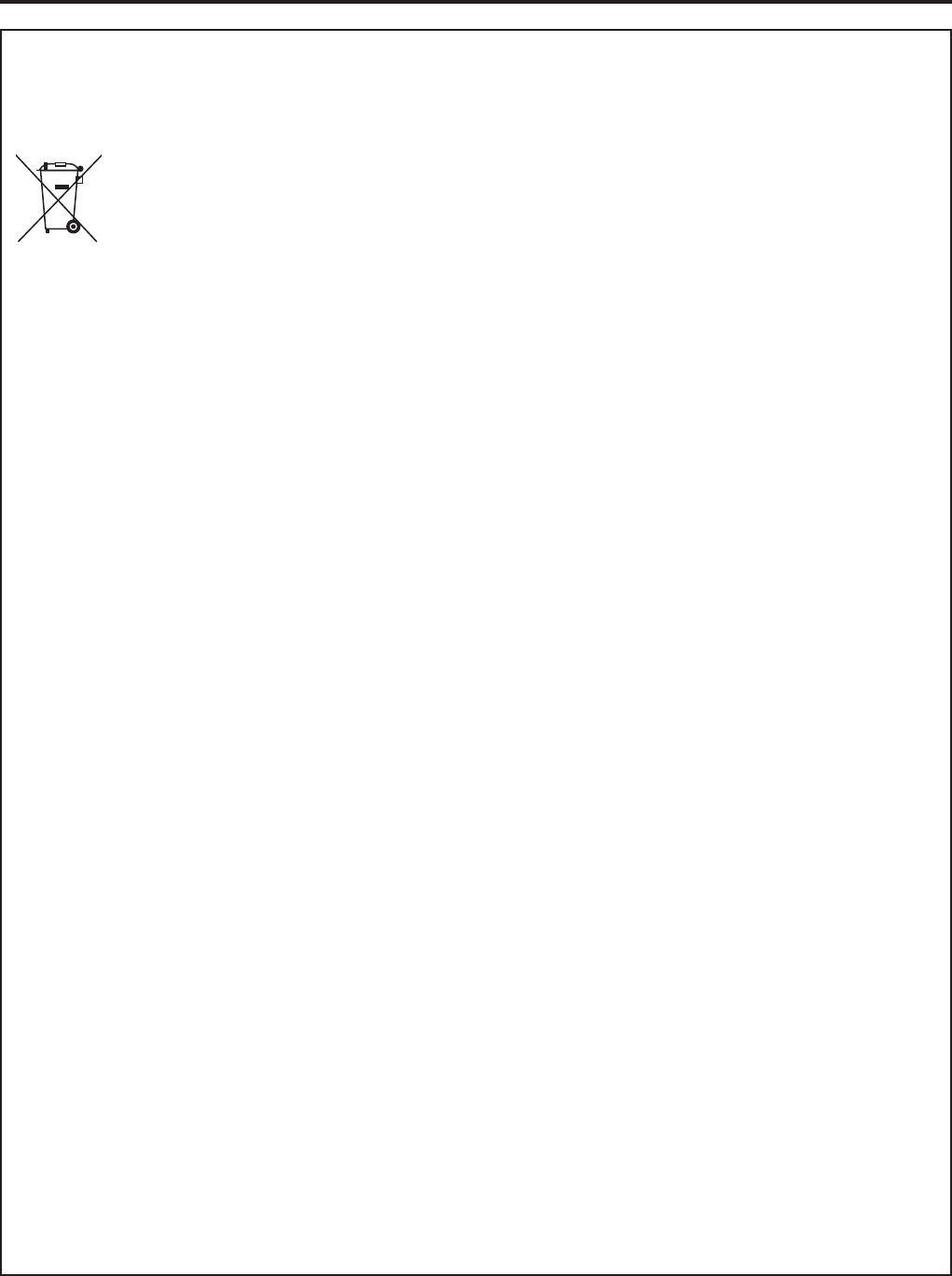
7
For the customers in Europe
Note: This symbol mark is for EU countries only.
This symbol mark is according to the directive 2002/96/EC Article 10 Information for users and Annex IV, and/or
to the directive 2006/66/EC Article 20 Information for end-users and Annex II.
This product is designed and manufactured with high quality materials and components which can be
recycled and/or reused.
This symbol means that electrical and electronic equipment, batteries and accumulators, at their end-of-life,
should be disposed of separately from your household waste.
If a chemical symbol is printed beneath the symbol shown above, this chemical symbol means that the
battery or accumulator contains a heavy metal at a certain concentration. This will be indicated as follows:
Hg: mercury (0,0005%), Cd: cadmium (0,002%), Pb: lead (0,004%)
In the European Union there are separate collection systems for used electrical and electronic products,
batteries and accumulators.
Please, dispose of this equipment, batteries and accumulators correctly at your local community waste
collection/recycling centre.
Please, help us to conserve the environment we live in!
Ihr MITSUBISHI ELECTRIC-Produkt wurde unter Einsatz von qualitativ hochwertigen Materialien und
Komponenten konstruiert und gefertigt, die für Recycling und/oder Wiederverwendung geeignet sind.
Dieses Symbol bedeutet, dass elektrische und elektronische Geräte sowie Batterien und Akkus am Ende
ihrer Nutzungsdauer von Hausmüll getrennt zu entsorgen sind.
Wenn ein chemisches Symbol unterhalb des oben abgebildeten Symbols erscheint, bedeutet dies, dass
die Batterie bzw. der Akku ein Schwermetall in einer bestimmten Konzentration enthält. Dies wird wie folgt
angegeben:
Hg: Quecksil
ber (0,0005 %), Cd: Cadmium (0,002 %), Pb: Blei (0,004 %)
In der Europäischen Union gibt es unterschiedliche Sammelsysteme für gebrauchte Elektrik- und
Elektronikgeräte einerseits sowie Batterien und Akkus andererseits.
Bitte entsorgen Sie dieses Gerät, Batterien und Akkus vorschriftsmäßig bei Ihrer kommunalen Sammelstelle
oder im örtlichen Recycling-Zentrum.
Bitte helfen Sie uns, die Umwelt zu erhalten, in der wir leben!
Votre produit Mitsubishi Electric est conçu et fabriqué avec des matériels et des composants de qualité
supérieure qui peuvent être recyclés et/ou réutilisés.
Ce symbole signie que les équipements électriques et électroniques, les batteries et les accumulateurs, à la
n de leur durée de service, doivent être éliminés séparément des ordures ménagères.
Si un symbole chimique est imprimé sous le symbole illustré ci-dessus, il signie que la batterie ou l’accumulateur
contient une certaine concentration de métal lourd. Elle sera indiquée comme suit :
Hg : mercure (0,0005%), Cd : cadmium (0,002%), Pb : plomb (0,004%)
Dans l’Union Européenne, il existe des systèmes sélectifs de collecte pour les produits électriques et
électroniques, les batteries et les accumulateurs usagés.
Nous vous prions donc de coner cet équipement, ces batteries et ces accumulateurs à votre centre local de
collecte/recyclage.
Aidez-nous à conserver l’environnement dans lequel nous vivons !
Les machines ou appareils électriques et électroniques contiennent souvent des matières qui, si elles sont
traitées ou éliminées de manière inappropriée, peuvent s’avérer potentiellement dangereuses pour la santé
humaine et pour l’environnement.
Cependant, ces matières sont nécessaires au bon fonctionnement de votre appareil ou de votre machine.
Pour cette raison, il vous est demandé de ne pas vous débarrasser de votre appareil ou machine usagé avec
vos ordures ménagères.
Su producto MITSUBISHI ELECTRIC está diseñado y fabricado con materiales y componentes de alta
calidad que pueden ser reciclados y/o reutilizados.
Este símbolo signica que el aparato eléctrico y electrónico, las pilas, baterías y los acumuladores, al nal de
su ciclo de vida, se deben tirar separadamente del resto de sus residuos domésticos.
Si hay un símbolo químico impreso debajo del símbolo mostrado arriba, este símbolo químico signica que
la pila, batería o el acumulador contienen un metal pesado con cierta concentración. Esto se indicará de la
forma siguiente:
Hg: mercurio (0,0005%), Cd: cadmio (0,002%), Pb: plomo (0,004%)
En la Unión Europea existen sistemas de recogida especícos para productos eléctricos y electrónicos, pilas,
baterías y acumuladores usados.
Por favor, deposite los aparatos mencionados, las pilas, baterías y acumuladores en el centro de recogida/
reciclado de residuos de su lugar de residencia local cuando quiera tirarlos.
¡ Ayúdenos a conservar el medio ambiente!
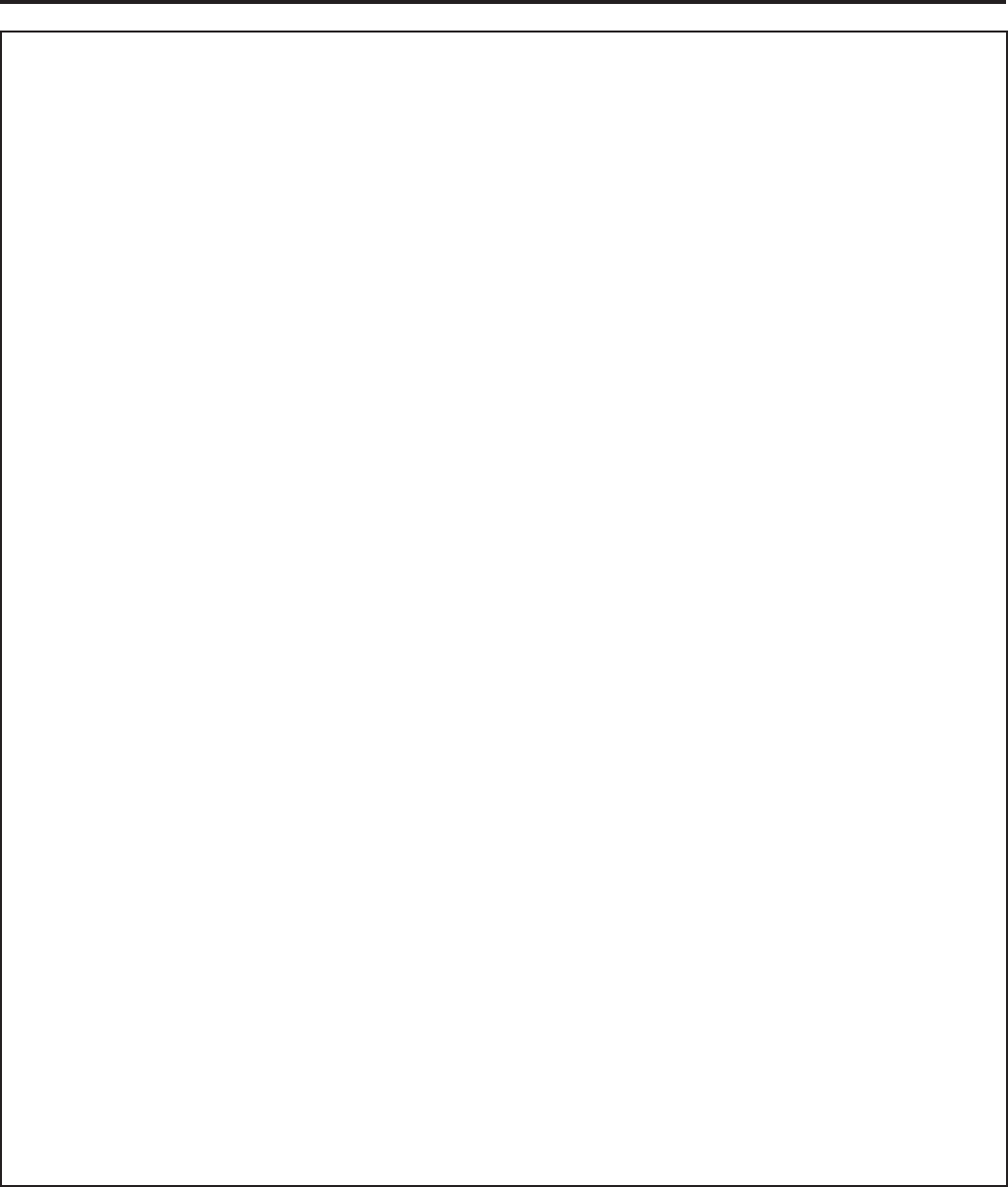
8
WARNING:
In the USA or Canada, use the AC power cord according to the recommendations as below, in order to comply with UL60950-1 and CAN/
CSA C22.2 No. 60950-1-03.
Connect to the 120 V receptacle of the room or the host equipment.
The AC power cord should be UL or CSA approved and consist of type SVT, size 16 or 18AWG, length 2 m or shorter cord with IEC60320-1/
C13 type, 125 V 10 A or higher rating connector and NEMA 5-15 type, 125 V 10 A or higher rating plug.
Use the AC power cord as specied above, so as not to interfere with radio and television reception.
If you use other cables, it may cause interference with radio and television reception.
ATTENTION:
Aux USA ou au Canada, utilisez le cordon d’alimentation CA en accord avec les recommandations ci-dessous, de façon à respecter les
normes UL60950-1 et CAN/CSA C22.2 No. 60950-1-03.
Connexion à une prise 120 V dans la chambre ou sur le générateur de l’hôte.
Le cordon d’alimentation CA doit être approuvé comme UL ou CSA et du type SVT, taille 16 ou 18 AWG, le câble doit être d’une longueur
de 2 m ou moins et du type IEC60320-1/C13, le connecteur doit être 125 V 10 A ou plus du type NEMA 5-15, la prise 125 V 10 A ou plus.
Utiliser le cordon d’alimentation CA comme indiqué ci-dessus, an de ne pas causer d’interférences avec la réception radio ou de la
télévision.
Si vous utilisez d’autres câbles, cela risque de causer des interférences avec la réception radio ou de la télévision.
WARNING:
In Europe, use the AC power cord according to the recommendations as below, in order to comply with EN60950-1.
Connect to the 230 V receptacle of the room or the host equipment.
The AC power cord should be VDE approved and consist of core size 0.75 mm2 or bigger, length 2 m or shorter cord with IEC60320-1/C13
type, 250 V 10 A or higher rating connector and CEE(7)VII type, 250 V 10 A or higher rating plug.
Use the AC power cord as specied above, so as not to interfere with radio and television reception.
If you use other cables, it may cause interference with radio and television reception.
WARNUNG:
Verwenden Sie in Europa ein Netzkabel in Übereinstimmung mit den unten aufgeführten Empfehlungen, damit der Norm EN60950-1
entsprochen wird.
Schließen Sie das Netzkabel an einen dementsprechenden 230 V-AC (Wechselspannung) Anschluß an.
Das Netzkabel muss VDE-zugelassen sein und einem Leitungsquerschnitt von mindestens 0,75 mm
2
oder größer haben. Zudem muss
es eine Länge von höchstens 2 m oder kürzer aufweisen und über einen Anschluss vom Typ IEC60320-1/C13 für 250 V 10 A oder höhere
Spannung und einen Stecker vom Typ CEE(7)VII für 250 V 10 A oder höhere Spannung verfügen.
Verwenden Sie ein wie weiter oben aufgeführtes Wechselstrom-Netzkabel, um Interferenzen mit dem Radio- oder Fernsehempfang zu
vermeiden.
Wenn Sie andere Netzkabel verwenden, kann dies zu Interferenzen mit dem Radio- und Fernsehempfang führen.
ATTENTION:
En Europe, veuillez utiliser le cordon d’alimentation CA en accord avec les recommandations ci-dessous, de façon à respecter les normes
EN60950-1.
Connexion à une prise 230 V dans la chambre ou sur le générateur de l’hôte.
Le cordon d’alimentation secteur d’un diamètre de 0,75 mm2 ou plus, d’une longueur de 2 m de type IEC60320-1/C13 est approuvé VDE.
La che secteur à pour référence 250 V 10 A et de type CEE(7)VII.
Utiliser le cordon d’alimentation CA comme indiqué ci-dessus, an de ne pas causer d’interférences avec la réception radio ou de la
télévision.
Si vous utilisez d’autres câbles, cela risque de causer des interférences avec la réception radio ou de la télévision.
ADVERTENCIA:
En Europa, utilice el cable de alimentación de CA de acuerdo a las recomendaciones siguiente, con el n de cumplir con el EN60950-1.
Conecte al receptáculo de 230 V de la habitación o del equipo antrión.
El cable de alimentación de CA debe ser aprobado de VDE y constar de un tamaño núcleo de 0,75 mm2 o superior, longitud del cable de
2 m o menos de tipo IEC60320-1/C13, conector con corriente nominal de 250 V 10A o superior y de tipo CEE(7)VII, enchufe de corriente
nominal de 250 V 10 A o superior.
Utilice el cable eléctrico de CA como se ha indicado anteriormente, para no interferir con la recepción de la radio y del televisor.
Si utiliza otros cables, puede ocasionar interferencias con la recepción de la radio y del televisor.

9
電源コードの注記
(ロシア、簡体、繁体、韓国、日
本)
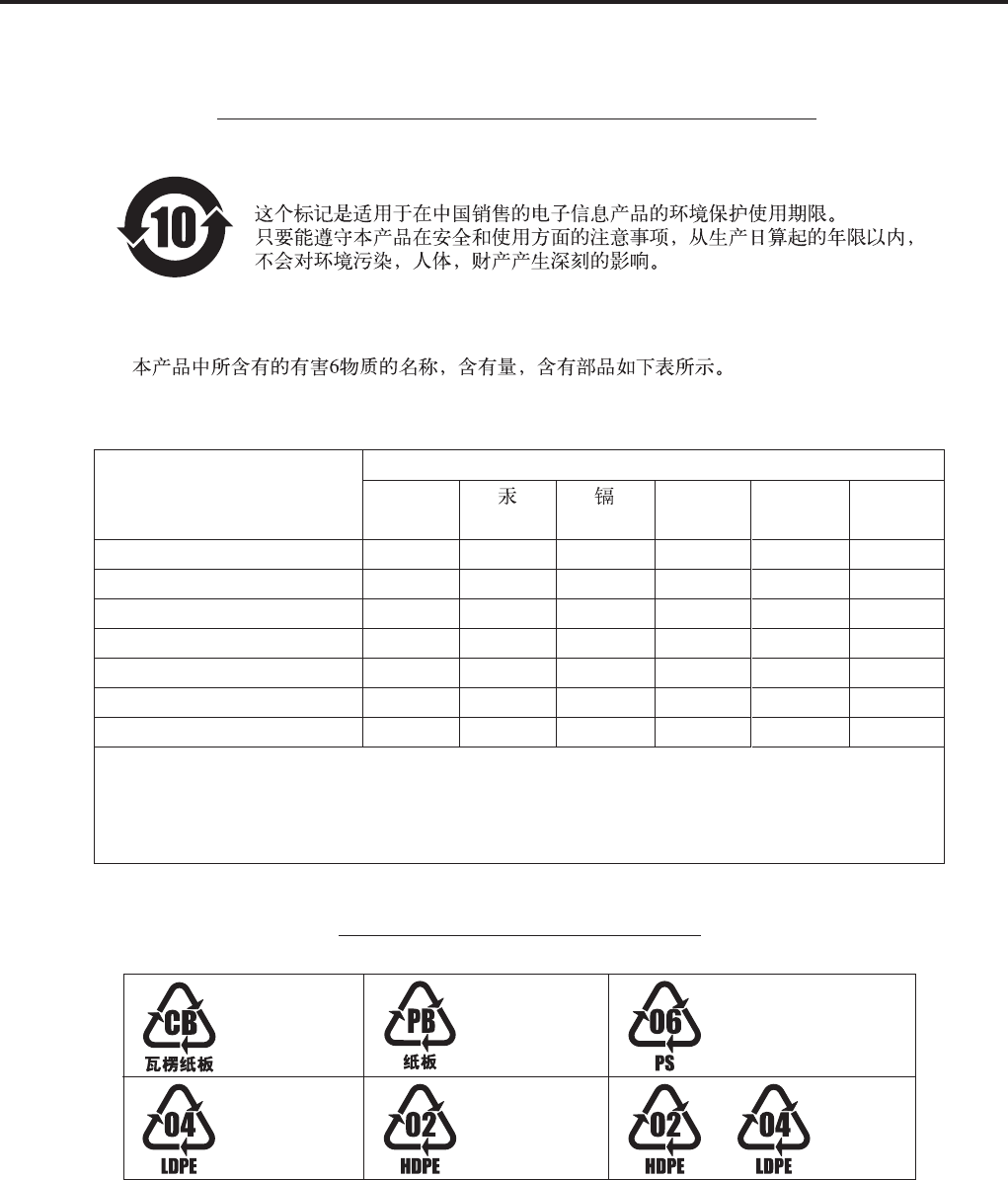
10
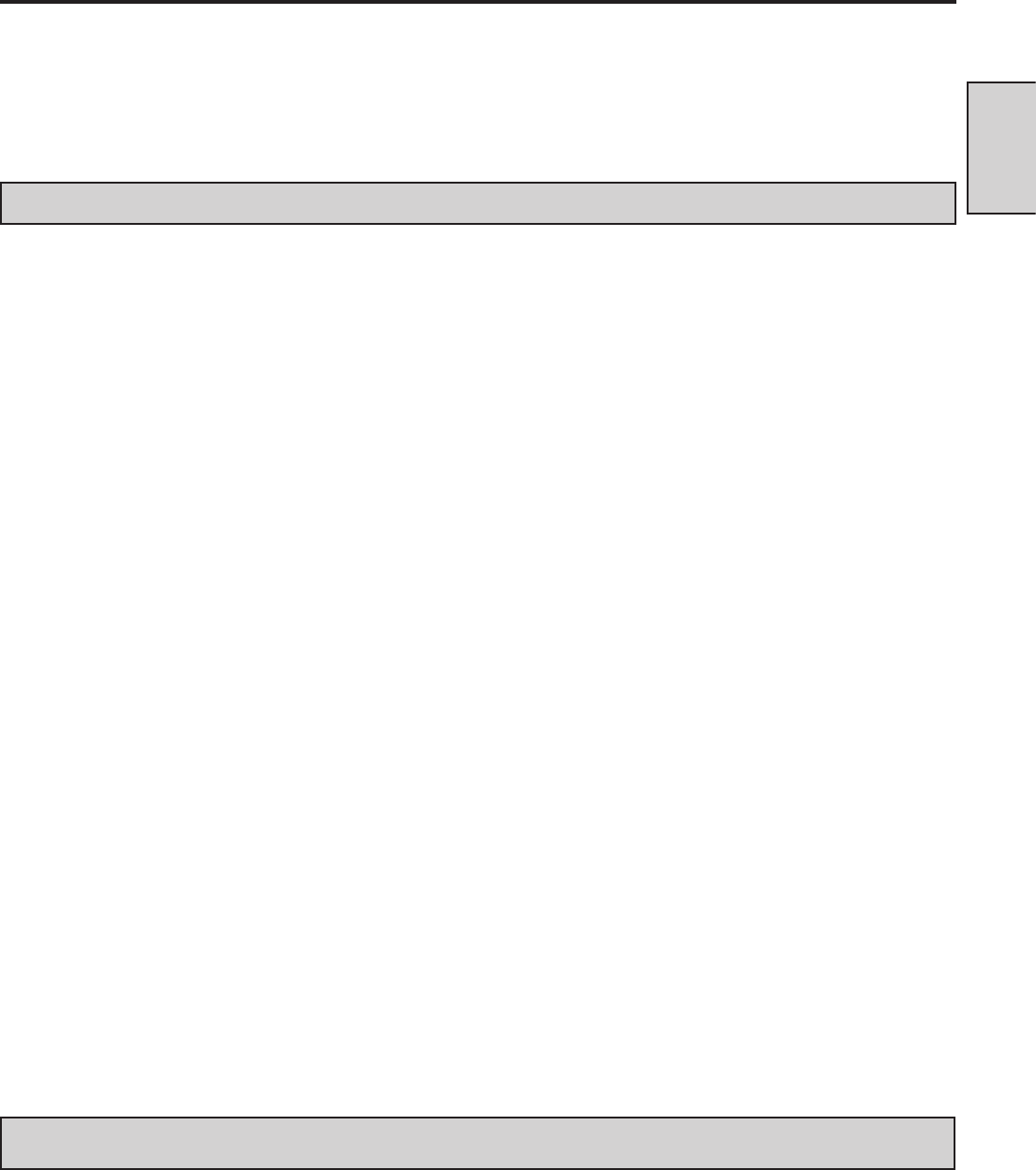
11
ENGLISH
SAFETY PRECAUTIONS
In the interest of safety, please observe the following precautions:
POWER REQUIREMENT
This Thermal Photo Printer is designed to operate on 120 V AC 50/60 Hz in the U.S.A. and Canada, and 220 V - 240 V AC
50/60 Hz in Europe. Never connect to any outlet or power supply having a different voltage or frequency.
WARNING : THIS APPARATUS MUST BE EARTHED.
PROTECTIVE MEASURES
IF ABNORMALITIES ARISE, .....
Use of the unit during emission of smoke or abnormal
sounds (without adopting countermeasures) is dangerous.
In such a case, unplug the power cord from the source
outlet immediately, and request maintenance service from
the sales dealer.
NEVER INSERT ANY OBJECT INTO THE UNIT
Foreign objects of any kind inserted into this unit constitute
a safety hazard and can cause extensive damage.
DO NOT PLACE ANYTHING ON THE THERMAL
PHOTO PRINTER
Heavy objects placed on the Thermal Photo Printer can
cause damage or obstruct proper ventilation.
PROTECT THE POWER CORD
Damage to the power cord may cause re or shock hazard.
When unplugging, hold by the plug only and remove carefully.
DO NOT PLACE WATER CONTAINERS ON THE UNIT
Do not place ower vases, and other water-holding
containers on the device. If, for some reason, water seeps
to the inside of the unit, unplug the power cord from the
source outlet, and contact the sales dealer. If used without
corrective measures, the unit may be damaged.
“In the interest of safety, avoid handling of liquids near the
unit.”
DO NOT REMOVE THE CABINET
Touching internal parts is dangerous, besides, it may lead
to malfunction. Contact the sales dealer to carry out internal
checks and adjustments. Before opening the cover for
eliminating a jammed paper, etc., be sure to disconnect the
power cord plug.
UNPLUG THE POWER CORD DURING A LONG
ABSENCE
Turn off the main power switch and unplug the power cord
during a long absence.
WHEN TRANSPORTING THE UNIT
When transporting the unit, remove the ink ribbon and
print paper from the unit. See “INSTRUCTIONS FOR
TRANSPORTATION” on page 20 of the detailed manual.
WHEN MOVING THE UNIT
Check that the printing unit is closed rmly. And pay
attention not to press the OPEN button accidentally. When
the printing unit is not closed rmly or you press the OPEN
button accidentally, the printing unit may open. It can cause
injury or damage.
BE CAREFUL AROUND PRINT PAPER EXIT SLOT
Don’t insert your hand or any material into the paper exit slot
during printing.
Do not touch the cutter blade inside the paper exit slot.
Otherwise, your nger will be injured.
DO NOT TOUCH THE THERMAL HEAD
Do not touch the thermal head (located inside the unit).
They are heated to high temperature and may cause burns
or injury when touched.
Also, malfunction caused by static electricity may occur.
WHEN PLACING THE PRINT PAPER, KEEP THE
PRINT PAPER UPRIGHT
When you put the print paper sideways on a table, etc., it
may roll and fall. This may cause injury.
REMOVE THE PAPER STRIP BIN WHEN OPENING
OR CLOSING THE DOOR
When you open or close the door with the paper strip bin
installed, the bin may be removed and fall. This may cause
injury or damage. Also, the chips generated by margin cut
may jam at the paper exit slot.
DO NOT LEAVE THE PRINTING UNIT OPEN
When the printer is moved with the printing unit open, it may
cause injury or damage.
CLOSE THE PRINTING UNIT FIRMLY
Take care not to pinch your hand when closing the printing
unit. When the printing unit is not closed rmly, it may open
during transportation and it may cause injury or damage.
DO NOT PUSH DOWN ON THE PRINTING UNIT OR
THE DOOR
If you push down on the printing unit or the door when they
are open, this unit may fall and it can cause damage or injury.
INSTALLATION LOCATIONS
SUITABLE LOCATIONS
Avoid shaky places or hot-springs areas where hydrogen
sulde and acidic ions are likely to be generated.
AVOID PLACES WITH HIGH HUMIDITY AND DUST
Do not place the unit at a high humidity and dusty locations.
They can cause extensive damage to this unit. Avoid places
where the unit is likely to be exposed to oily fumes and
vapors.
AVOID PLACES LIKELY TO BE EXTREMELY HOT
Places exposed to direct sunlight, or near heating appliances
can attain extremely high temperatures, which may deform
the cabinet, or can become a prime cause of damage.
PLACE THE UNIT ON A HORIZONTAL LEVEL
Place this unit on an even, horizontal and stable place. The
unit is likely to be affected if it is placed in slanted conditions
or in an unstable places.
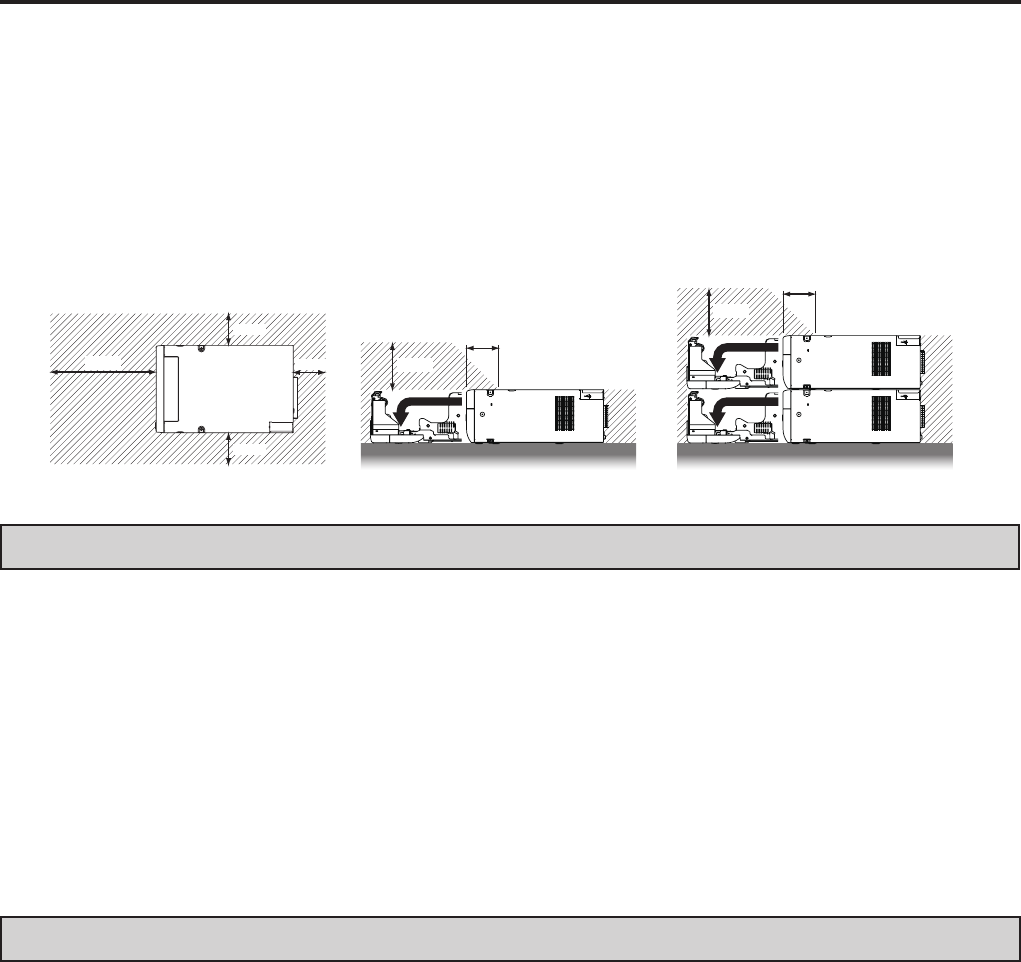
12
PROTECT AGAINST DEW FORMATION
In extremely cold regions, if the unit is moved quickly from
an extremely cold place to warmer one, dew is likely to be
formed. If dew is formed, printing is not possible.
OPERATING AMBIENT TEMPERATURE RANGE
The operating ambient temperature range is 5°C - 35°C
(41°F - 95°F) and the humidity of 30% - 80% RH. When
using the unit on the system rack, be sure to keep this
ambient temperature inside the rack.
When the printer is used in a low temperature, it may take
some time to start printing.
SAFETY PRECAUTIONS
MAINTAIN GOOD VENTILATION
Ventilation slots and holes are provided on the rear and both
sides of this unit. Place the unit on a hard and level surface and
keep a space between the unit and the walls to ensure proper
ventilation. However, take care that a wind does not directly
blow into the front of the unit (print outlet). When putting the
unit on the system rack, take a space between the unit and the
back and sides of the rack.
Secure a minimum space described below.
FOR LONG OPERATING LIFE
UNSUITABLE MATERIALS FOR THE THERMAL
PHOTO PRINTER
Coat aking and deformation are likely to occur if the unit is
wiped with chemical dusters, benzine, thinner or any other
solvent, if rubber or PVC items are left in contact with the unit
for extended duration, or if the unit is sprayed with insecticide.
CARE OF THE CABINET
Unplug and clean with a soft cloth slightly moistened with a mild
soap and water solution. Allow to dry completely before operating.
Never use petroleum base solutions or abrasive cleaners.
HEAD ABRASION
The thermal head, like the video head, wears out. When it
is abraded, it becomes hard to print out ne details of the
picture. In such a case, it is necessary to replace the thermal
head. Consult with the sales dealer for replacing the head.
CONNECTING DEVICES
Read thoroughly “Operating Precautions” of the instruction
booklets for the devices connected with the Thermal Photo
Printer. The power cord must be disconnected after printing is
over.
CAUTION ON RELOCATING
When transporting this unit, make sure it is not likely to be
subjected to impacts. They can be a prime cause for damage.
Further, make sure to disconnect the power cord from the
power outlet, and the cables from the connected devices.
OTHER CAUTIONS
• Do not pull out nor touch the print paper until printing is
completed. It may degrade the print quality or cause an
error.
• Dust or other foreign matter adhering to the print paper
or the ink cassette, or deformation resulting from
exposure to extremely low or high temperatures could
cause loss of color, uneven color or lines, or wrinkles in
the print images.
• Depending on the internal temperature, the printer may
stop printing temporarily during printing. (The POWER
indicator blinks green.) Please wait for the printer to
resume printing.
Do not touch the print paper.
• Each time printing is completed, remove the prints. If the
prints are not removed, a paper jam may occur.
• Empty the paper strip bin whenever you pull out the
printing unit for the purpose such as replacing the print
paper or ink ribon to prevent jamming the strips at the
print outlet.
• The paper tray is used for storing the cut print paper
temporarily. The print paper may fall from the tray or may
not be stored in the printed order.
NOTE:
YOUR UNDERSTANDING IS REQUESTED FOR THE
LOSS OF IMAGES IN MEMORY DUE TO THE SUDDEN
OCCURRENCE OF A MALFUNCTION.
10 cm
10 cm
10 cm
40 cm
Top view
15 cm
7 cm
15 cm
7 cm
Side view Side view (double stack)
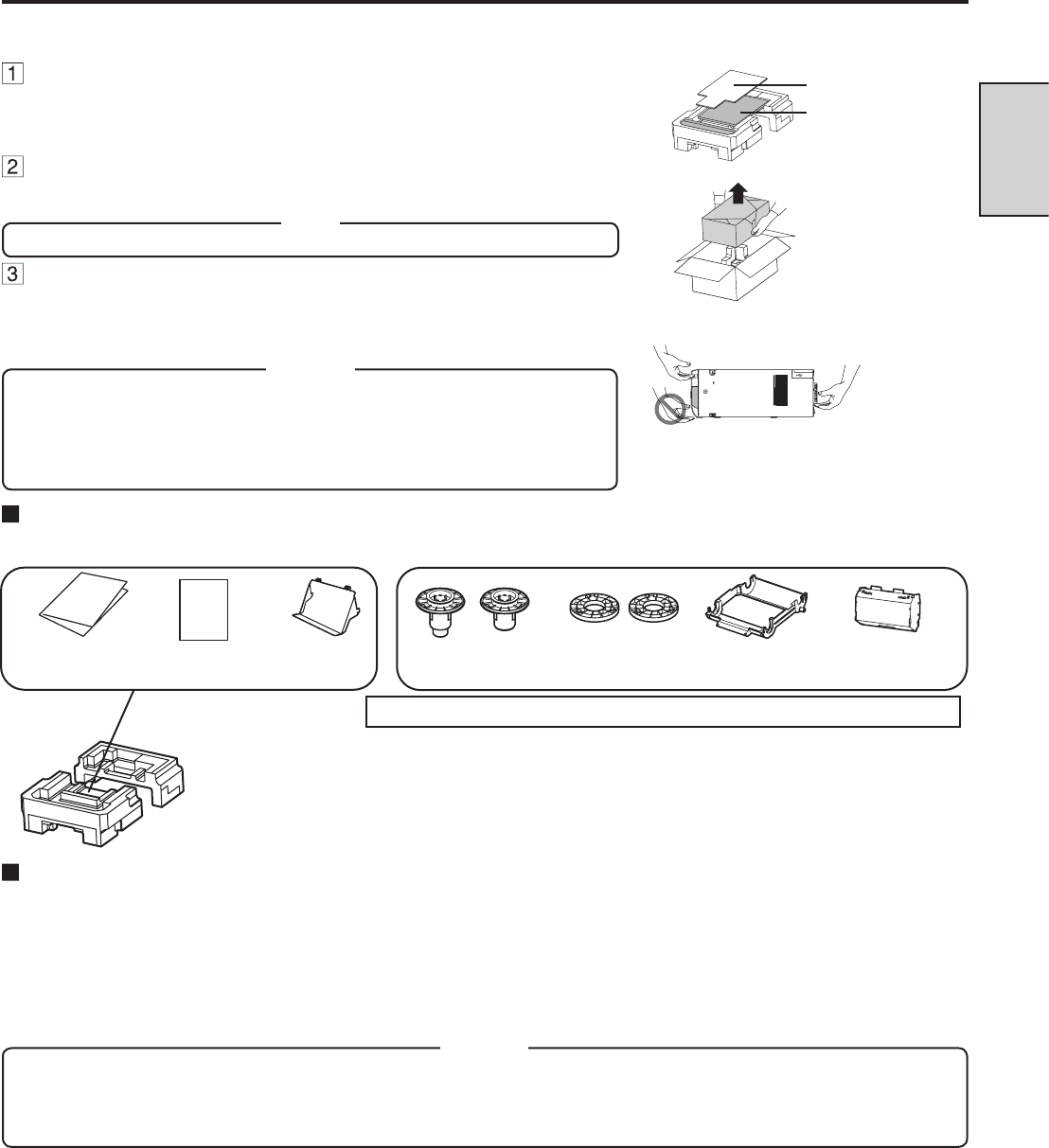
13
ENGLISH
NOTE
Do not use 10x15 (4x6”) or 15x20 (6x8”) size paper (having width of 152 mm) after starting the use of 9x13 (3x5”) or 13x18
(5x7”) size paper (having width of 127 mm) .
If doing so, some lines may appear at the width of 127mm of 9x13 (3x5”) or 13x18 (5x7”) size paper. In this case, the
thermal head replacement is required.
Take the unit out of the box by the following procedures and illustrations. Make sure the contents of the accessory
are all included.
UNPACKING
PAPER / INK RIBBON SET
When using this unit, make sure to use the following types of the paper / ink ribbon set. Remove the spacers from the paper
anges when using other than CK-D735 and CK-D757.
Product name Print size Number of prints
CK-D735 9x13 (3.5x5”) 450
CK-D746 10x15 (4x6”) 400
CK-D757 13x18 (5x7”) 230
CK-D768 15x20 (6x8”) 200 (soon-to-be-available)
CONTENTS
The accessories items are placed in the top cushion. Check all items are included.
Paper anges Spacers Ink cassette
Operation
manual Paper strip bin
Detailed
manual
Make sure to remove the protective materials from the ink cassette and paper anges.
Open the printer box from the top and remove the top
cushion containing the accessories out of the box.
Remove the protective cardboard and then take the accessories out of the
cushion.
Carefully pull the printer up and out of the box.
Pull the printer straight up as shown in the gure.
NOTE
Printer weighs about 12 kg. Handle with care.
Unwrap the packing.
Remove the protective materials for transportation such as protective sheet.
Remove the paper strip bin before carrying the printer.
Hold the printer by the front and rear handle as illustrated in the drawing.
CAUTION
• Do not carry the printer with the paper strip bin attached and by holding
the part under the paper strip bin. The paper strip bin may be removed
and fall. It may cause injury or damage.
• When the printing unit is not closed rmly or you press the OPEN button
accidentally, the printing unit may open. It can cause injury or damage.
Paper tray
Protective cardboard
Accessories
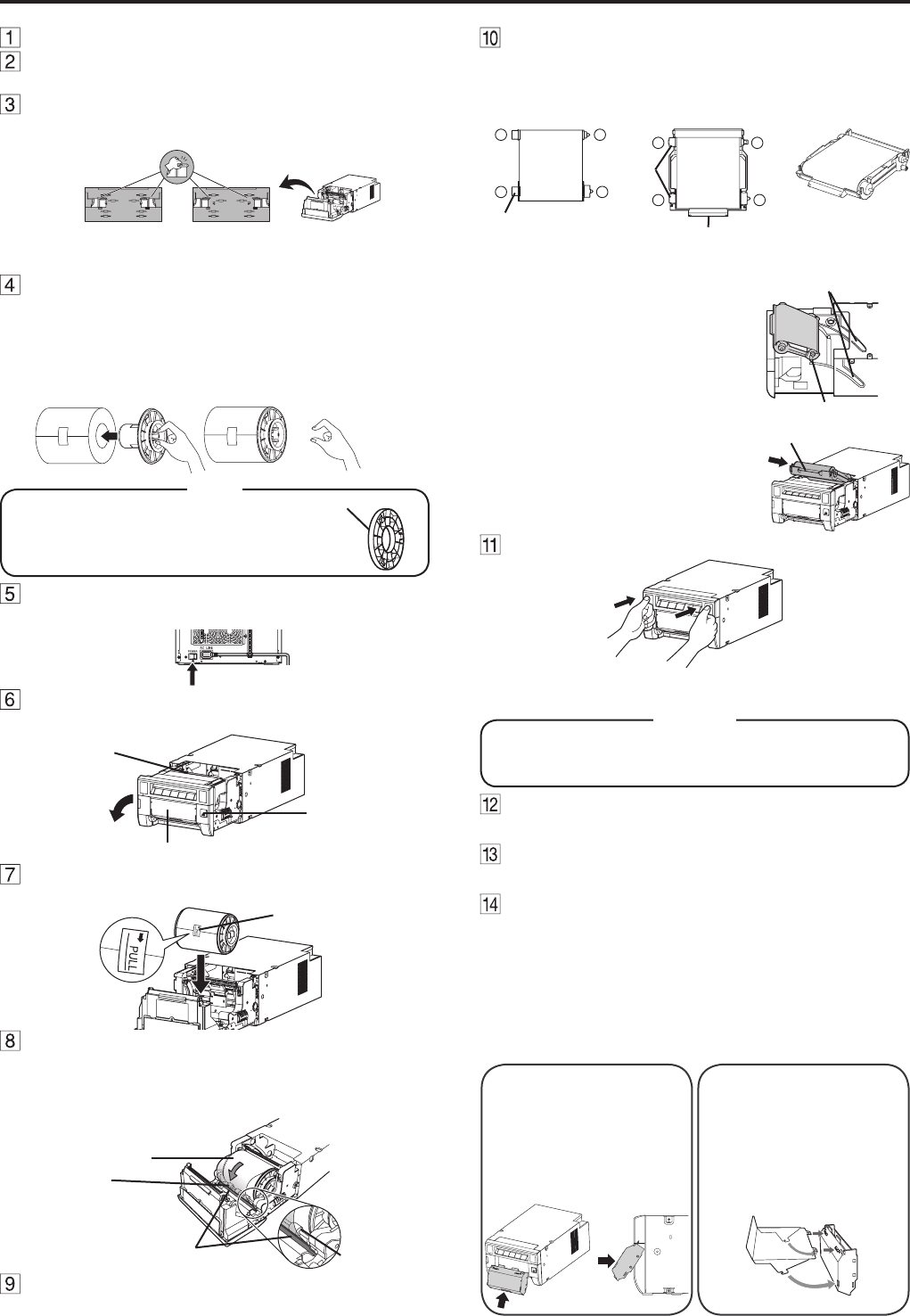
14
BEFORE OPERATION
Load the ink ribbon in the ink cassette to
the unit.
Before installing the ink cassette into this unit, load the ink
ribbon (supplied as the PAPER/INK RIBBON SET) in the ink
cassette as shown below.
below.
34
1 2
Handle
34
1 2
Shaft
Ditch
Ink ribbon Ink cassette
To insert the ink cassette,
align the protrusions on both
sides of the cassette with the
right and left guides inside the
printing unit and slide it in a
slanting direction.
Mount the ink cassette to the
back rmly by holding the
handle.
Spacer
For 9x13(3.5x5”) or
13x18(5x7”) size
paper (5”-width)
For 10x15(4x6”) or
15x20(6x8”) size
paper (6”-width)
Take the unit out of the box.
Press the OPEN button to release the
printing unit out.
Position the adjustable paper guides.
Pinch the tab on the adjustable paper guide and slide it right
or left.
Attachthesuppliedpaperangestoboth
sides of the print paper.
When you pinch the latches on the paper ange, the stoppers
retract into the shaft. Attach the anges to the print paper with
the stoppers retracted.
Make sure that the anges are attached to the print paper
securely, and release the latches.
NOTE
When using other than CK-D735 and
CK-D757, remove the spacer from the
paper ange. (See page 11 of the detailed
manual.)
Press the POWER switch on the rear
panel to turn on the power.
Remove the paper strip bin and then pull
the knob to open the door.
Knob
Paper strip bin
OPEN button
Install the print paper into the unit.
Make sure the paper roll is rmly installed.
Sticker
Remove the sticker, insert the print paper
between the roller and guide as shown
below, and feed the print paper until the
buzzer sounds.
Print paper
Roller
Roller
Guide
Close the door.
Handle
121
2
Protrusion
Guide
Push the printing unit to close.
Close the printing unit by pushing the right and left sides of the
unit from the front with both hands.
CAUTION
When closing the printing unit, be careful not to get your
hands caught between the printer and the printing unit.
Otherwise, you may get injured.
Turn on the power of the personal
computer to be connected.
Connect the printer and the personal
computer with a USB cable.
Install an application software (separately
prepared) according to a system to be
used.
PAPER STRIP BIN
Hook and pull up the paper
strip bin to attach it rmly.
Hold and pull the handle on
the lower part of paper strip
bin to remove.
PAPER TRAY
Engage the upper hooks of
the tray on the protrusions on
the top of the margin cut box
(1). Then, secure the tray by
engaging the lower hooks in
the holes on both sides of the
box (2).
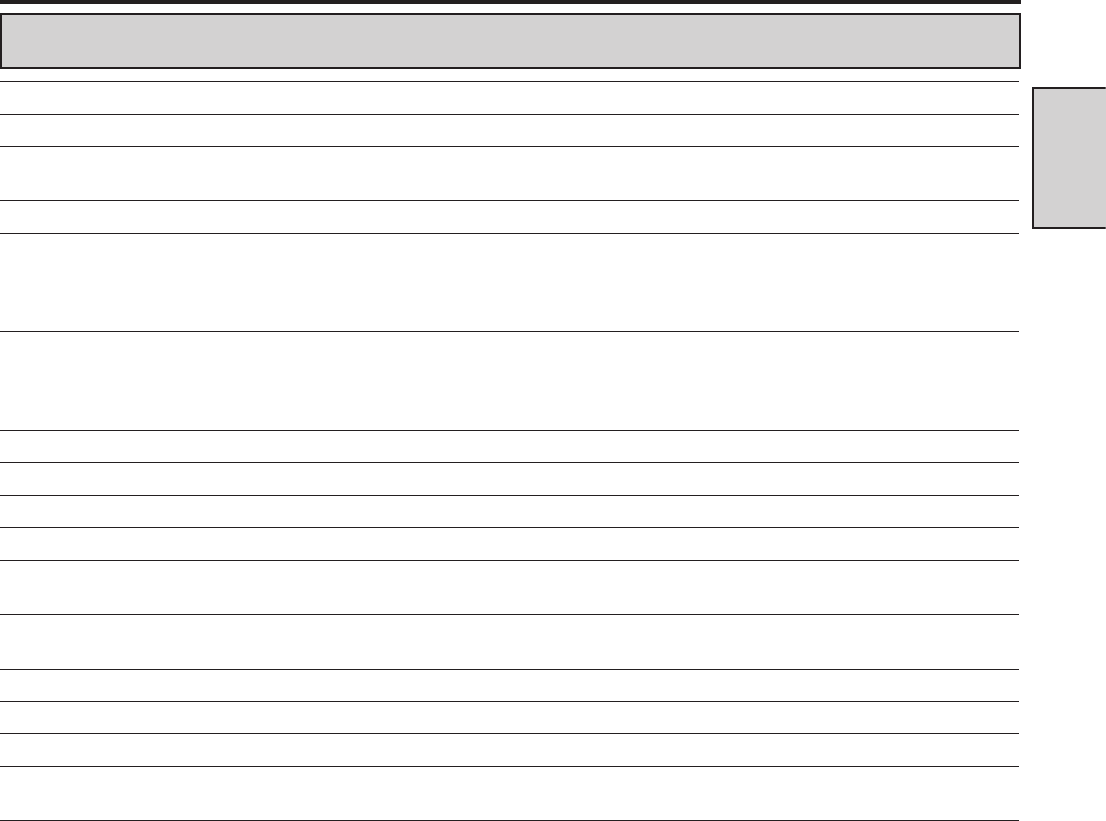
15
ENGLISH
SPECIFICATIONS
Class Thermal Photo Printer
Model ASK-300
Printing method Sublimation Dye Thermal Transfer line print
3-color faces progressive printing (yellow, magenta, and cyan) and surface lamination
Print’s resolution 300 x 300 dpi (dpi : dots per inch)
Dot resolution 9x13 (3.5x5”)
10x15 (4x6”)
13x18 (5x7”)
15x20 (6x8”)
1076 x 1568 dots
1228 x 1864 dots
1568 x 2128 dots
1864 x 2422 dots
Print size 9x13 (3.5x5”)
10x15 (4x6”)
13x18 (5x7”)
15x20 (6x8”)
89 x 127mm (without frame)
102 x 152mm (without frame)
127 x 178mm (without frame)
152 x 203mm (without frame)
Gradations 256 (8 bits) for each color
Supply method Automatic
Interface Hi-Speed USB (Ver.2.0)
Power supply 220 - 240 V AC 50/60 Hz, 120 V AC 50/60 Hz
Power consumption 2.4 A (220 - 240 V AC, 50/60 Hz)
4.6 A (120 V AC, 50/60 Hz)
Operating conditions Temperature : 5°C - 35°C
Humidity : 30% - 80% RH (no dewing)
Installation conditions Operating attitude : Horizontal ±5°
Outside dimensions 275(W) x 446(D) x 170(H) mm
Weight Approx. 12 kg (excluding accessories)
Standard accessories
Ink cassette (1), Paper ange (1 set), Spacers (2), Operation manual (1), Detailed manual (1),
Paper strip bin (1), Paper tray (1),
Print size and outside dimensions show typical value.
Design and specications are subject to change without notice.
SPECIFICATIONS